| Step Right Up! Bob Brooke presents the history
of the circus in America.
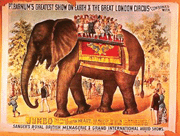 |
A
poster featuring Jumbo, the world's largest elephant. |
AMERICA’S LOVE affair
with the circus has lasted for over 200 years. It outlasted the minstrel show, the
medicine show and vaudeville. It glitters with spangles, smells of fresh sawdust and
excited animals, tastes like peanuts and popcorn, and sounds like an old-time calliope.
Ernest Hemingway, a lifelong circus lover, once wrote, “The circus is the only
ageless delight that you can buy for money. Everything else is supposed to be bad for you.
But the circus is good for you. It’s the only spectacle I know that, while you watch
it, gives the quality of a truly happy dream.”
The Beginnings
The circus came to the US on 3 April 1793. John Bill Rickets, an English equestrian rider,
used a ring and added acrobats, a rope walker and a clown to his equestrian act. But the
circus didn’t have an elephant — at least not yet.
The elephant didn’t get into the circus until the 1800s. Hackaliah Bailey, a farmer
from Somers, New York, had a brother who was a sea captain. The brother, while in London,
bought a female African elephant at auction for $20 and sold it to Bailey for $1,000.
The captain put the elephant on board a sloop bound up the Hudson River for Sing Sing, the
nearest river town to Bailey’s home. Bailey walked the animal, which he called Old
Bet, from Sing Sing to Somers, 56 miles away. He walked the elephant only by night so that
the public wouldn’t glimpse the beast along the route “for nothing”. During
the day, he exhibited the elephant for a small fee and began to make a profit.
Bailey’s success encouraged others to invest in unusual animals for exhibition and
take them on tour. Unfortunately, a ruffian in Maine shot Old Bet to death in 1816.
Old Bet’s death didn’t stop her from going on exhibition. Nine months later,
advertisements began appearing in New York newspapers saying that Bailey had had the
remains of Old Bet stuffed and preserved. For the next four years, Old Bet’s remains
toured New England.
After John Bill Rickets was lost in a shipwreck as he headed for England, the circus in
America almost disappeared. No superstars like Rickets caught the fancy of the public.
However another idea was catching on: the traveling menagerie.
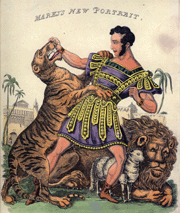 |
Lion
tamer Isaac Van Amburgh (courtesy Circus World Museum). |
The Menagerie
At first, entrepreneurs put individual wild animals on display and charged admission. As
time went by, exhibitors began adding more animals to their shows. By the early 1820s
there were 30 or more traveling menageries touring the eastern US. It wasn’t until
the late 1830s that promoters figured out a way to combine the menagerie with the circus.
Cat acts in the US began in 1833, when Isaac Van Amburgh first stepped into a cage
occupied by a lion, a tiger, a leopard and a panther. Dressed like a Roman gladiator in
toga and sandals, Van Amburgh emphasized his domination of the animals by beating them
into compliance with a crowbar and thrusting his arm into their mouths, daring them to
attack. When he came under attack for spreading cruelty and moral ruin, Van Amburgh quoted
the Bible: “Didn’t God say in Genesis 1:26 that men should have dominion over
every animal on the earth?” To enhance his case, Van Amburgh actually acted out
scenes in the Bible, forcing a lion to lie down with a lamb and even bringing a child from
the audience to join them in the ring.
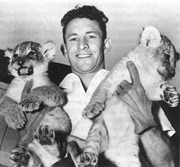 |
Clyde
Beatty was one of the circus' great wild animal trainers (courtesy Circus World Museum).
|
Van Amburgh’s vicious
theatrics gave rise to the so-called American style of feline acts, a style that reached
its peak a century later with Clyde Beatty.
The press regularly attacked circuses. A Staten Island newspaper pointed out that a single
visit of the Great Eastern Circus took from the community “enough money to sustain
three missionaries among the heathen for a year.”
Eventually, menageries began using equestrians and clowns to present performances in
circus rings, so the distinction between circus and menagerie gradually faded. They
traveled at night in wagon trains over country roads often a foot deep in mud, covering
only two or three miles an hour. These were the so-called mud shows. The longest distance
they could cover was 10 or 15 miles. A hostler rode ahead of the wagons to find the
shortest route and to “rail” every fork and crossroad by taking a rail from a
farmer’s fence and placing it across the road that was not to be taken so that the
wagons would avoid making a wrong turn.
An advance agent ballyhooed the show, arriving on horseback about a week ahead of it. He
would ring a bell, beat a drum, or blow a bugle to get folks’ attention, then talk up
the show while persuading tavern owners and storekeepers to let him tack up his bills,
usually in return for free passes to the performance.
On circus day, a clown would come into town a couple of hours before the circus enticing
the townspeople with acrobatics, clowning and snappy jokes. Then the wagons would arrive.
The regular members of the troupe split the profits, with each expected to perform several
jobs. Owners seldom paid salaries.
The ring was always the heart of the circus. When the circuses first took to the roads,
they played in enclosures made by surrounding the ring with sailcloth sidewalls stretched
around posts and trees. There was no roof, so if it rained, the show couldn’t go on.
Joshua Purdy Brown, another native of Somers, New York, put up the first circus tent in
Wilmington, Delaware, in 1825. The simple idea of a canvas tent that was easily portable
yet kept both rain and blazing sun off performers and spectators alike proved the perfect
innovation.
The following year, Nathan Howes pitched a round tent 90 feet in diameter over his ring.
On a windy day, the tent sounded like a windjammer under full sail. This was the first Big
Top.
While European circuses had tents designed with four center poles forming a square to
accommodate their one-ring design while expanding the area for seating, the American Big
Top put its tent poles in a single-file line as the circus expanded into two, and then
three, rings, enlarging the area for performers as well as the audience.
P.T. Barnum
Phineas Taylor Barnum was born on 5 July 1810, in Bethel, Connecticut, only 20 miles from
the part of New York state that was becoming famous as a cradle of the circus at the very
time when Hackaliah Bailey was exhibiting Old Bet. Barnum met Bailey while he was owner of
a retail fruit and confectionery store in Bethel. Bailey made a lasting impression on
Barnum.
In 1841, Barnum purchased Scudder’s American Museum on Broadway in New York City. He
exhibited “500,000 natural and artificial curiosities from every corner of the
globe”, and kept traffic moving through the museum with a sign that read, “This
way to the egress” — “egress” was another word for exit, and
Barnum’s patrons would have to pay another quarter to reenter the museum!
Barnum introduced the freak show to the circus. What interested him about freaks was not
that they were deformed but that they were unique. Barnum knew how much people wanted to
see the rare and exotic in their own species as well as others, and on that he built his
circuses.
Barnum was 60 years old when “P.T. Barnum’s Grand Traveling Museum, Menagerie,
Caravan, and Circus” made its debut. At the time, it was the largest circus venture
in American history. “We ought to have a big show,” Barnum said. “The
public expects it, and will appreciate it.” Appreciate it they did: Barnum grossed
$400,000 in his first year of operation.
The Golden Age
The 1850s ushered in the golden age of the circus. By 1852, about 30 circuses were touring
the US. Most had menageries. The circus was the country’s most popular form of
entertainment because its traveling shows went to the people and often gave them the only
entertainment they had all year. Competition among the various circuses created this
golden age, as each circus tried to outdo the others with a show more spectacular than
circusgoers had ever seen.
The decade of the 1850s also stands as the golden age of the river, an era when river
traveling in general and showboats in particular were at their height. Charles W. Rogers
built the first circus showboat, called the Floating Palace, for $42,000. Originally,
chimes on the roof heralded the approach of the boat until J.C. Stoddard of Worcester,
Massachusetts, invented the steam calliope. Nixon and Kemp’s circus put the calliope
on wheels and used it in their circus parade in 1857. That same year, Thomas Patent
invented “Fairy Floss”, otherwise known as cotton candy, the most popular
confection of the circus.
When the Civil War ended in 1865, P.T. Barnum was the biggest promoter of individual
attractions the world had ever known, but he was primarily an exhibitor of curiosities,
human and otherwise, not a circus man. He mounted a giant show requiring 500 people and
horses to transport it from town to town. He chose William C. Coup, a supreme showman, as
manager of this gigantic enterprise.
Together with Dan Castello, who had his own circus, and Barnum’s backing, Coup
assembled 10 carloads of trained animals and circus paraphernalia and shipped them to New
York. The great enterprise of Barnum, Coup and Castello opened in Brooklyn beneath 33
acres of canvas. The show boasted that it employed more people and animals than any
previously organized in the US or Europe. Over 10,000 people came to see 600 horses and
some of Barnum’s best wonders.
Though Barnum’s freaks had big drawing power, it was Coup’s advance publicity,
advertising and transportation arrangements that made the show a success. Coup posted
advertising bills as far as 75 miles away. To make sure all the people who saw his posters
could get to his circus, he arranged for railroads in New England and New York to run
special excursion trains at reduced fares to the places where the Barnum show pitched its
tents. Attendance was often two or three times the population of the city played.
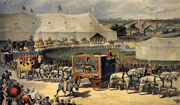 |
Circuses
were often promoted by means of parades, as seen in this 1891 engraving (courtesy Circus
World Museum). |
The Ringling Brothers
Circus Trains
On 10 May 1869, the Union Pacific and the Central Pacific Railroads were connected at
Promontory Point, Utah, creating new opportunities for circuses. The Castello circus was
the first to ride the rails to the West Coast on the new Union Pacific. While technically
a wagon show, it continued to carry enough horses for overland moves when a performance
was miles from the nearest railroad line. The menagerie animals made the trip inside 10
caged wagons aboard the train. Baggage wagons on flatcars carried show gear.
The use of rail travel paved the way for America’s distinctive three-ring circuses,
because trains could carry many more people, animals and pieces of equipment, allowing
circuses be to larger.
Circuses could also choose which towns to play. Until this point, a show was limited by
how far its baggage stock horses could walk overnight. Many times this meant having to
stop in towns that gave only limited patronage. Now trains carried circuses to towns
hundreds of miles away, while performers got a good night’s sleep.
Though Barnum took credit for it, it was Coup’s idea to design a special circus
train. Railroad cars at the time weren’t designed to be loaded and unloaded
efficiently, but Coup solved this problem by building railroad cars designed for the needs
of circuses. So he ordered 65 such cars built to his specifications. His design would
eventually lead to the development of the modern “piggyback” system of rail
truck freight handling.
The circus season of 1872 was the first year that a train carried a circus completely
designed for rail travel. Coup hit on the idea of loading his train using crossover plates
between the cars. Roustabouts pulled the wagons up a ramp onto the rear flatcar and pushed
them the length of the train. They would then be chocked into place on their assigned
flatcars with wedges to hold them steady. Until then, roustabouts had to manhandle wagons
over the side of each freight car, a difficult and time-consuming process.
Also in 1872, Coup and Barnum added a second ring to their show. Their reasoning was that
they could put more people around two rings than around one. Audiences loved it, as they
felt that they were getting more for their money. Performers hated it, as they felt that
they were in competition with the acts in the other ring.
The Greatest Show on Earth
The ever-growing size of the Barnum circus started people saying that it was “The
Greatest Show on Earth.” And Barnum eventually made that title the copyrighted name
of his show — “P.T. Barnum’s Traveling World’s Fair, Great Roman
Hippodrome and Greatest Show On Earth”. Eventually, Coup sold out to Barnum. In 1876
Barnum presided over the US centennial as if it were his personal anniversary.
About 1880, Barnum started to worry that his “Greatest Show on Earth” might not
be the greatest after all. For the first time, he had a serious challenger, the
international Allied shows, owned by James E. Cooper, James Anthony Bailey and James L.
Hutchinson. It was the circus being talked about. And it was the first to advertise the
use of electricity instead of gas to illuminate the two rings — all without mishaps.
The managerial genius among the three owners was Bailey. Barnum offered Hutchinson a free
partnership in his show if he’d persuade Bailey to combine with Barnum, and in 1880
the three reached an agreement to combine the shows under the firm name of Barnum, Bailey
and Hutchinson. The result was “P.T. Barnum’s Greatest Show On Earth, And The
Great London Circus, Sanger’s Royal British Menagerie and The Grand International
Allied Shows United.” It soon became known as the “Barnum and London
Circus”.
Bailey was a perfect partner for Barnum. No one could draw attention to his individual
attractions like Barnum and no one could get the whole show on the road like Bailey. For
the first time in history, they used three rings. The New York Herald called the three
rings a drawback because “the spectator was compelled to receive more than his
money’s worth; in other words, that while his head was turned in one direction he
felt it was losing something good in another.”
One of Barnum’s biggest successes came in 1882 with his acquisition of Jumbo. Dubbed
“The Towering Monarch of His Mighty Race, Whose Like the World Will Never See
Again,” Jumbo arrived in New York on Easter Sunday, 1882, in time for the annual
opening of The Greatest Show on Earth at Madison Square Garden. In the first six weeks, he
helped the show gross $336,000.
Jumbo was the greatest circus attraction in American history. He traveled in a private
railroad car which Barnum called “Jumbo’s palace car”, a crimson and gold
boxcar with huge double doors in the middle to give Jumbo easy access up a ramp. Twelve
feet tall at the shoulders and weighing six and a half tons, Jumbo could reach an object
26 feet from the ground with his seven-foot trunk.
In 1883, Barnum staged his greatest promotional coup by walking Jumbo across the Brooklyn
Bridge to test the strength of the new engineering marvel.
Unfortunately, Jumbo met with a disastrous accident in the town of St. Thomas, Ontario, in
the early morning of 15 September 1885, when a speeding freight train killed him while he
was being loaded into his car.
Barnum and Bailey then went their separate ways, but rekindled their business relationship
two years later. Barnum agreed to give Bailey control of the show and to add his name for
the first time to the actual title of the circus. From then on it was officially the
Barnum and Bailey Greatest Show on Earth.
Following the death of P.T. Barnum in 1891, James A. Bailey carried the Barnum and Bailey
Circus to new heights of popularity. The Greatest Show on Earth rode the rails on 85
railroad cars, employed more than 1,000 people, and consisted of five rings and stages,
plus the largest traveling menagerie anywhere.
Circus day at the turn-of-the-century involved the whole community in a way that the small
size of the average circus had not required previously, and that the sprawling size of
towns and cities hasn’t permitted since. In those days, nearly every community had a
convenient open space, large enough to accommodate a circus and near enough for the circus
to unload the train, give a free street parade through the center of town, and get back in
time to give the matinee on schedule.
There were no movies, radio or television to compete with the wonders of the circus ring
and little traffic congestion or parking problems to impede those who sought to attend.
The lots were almost always big enough to contain every buggy and the few automobiles that
came. Labor and transportation costs were low. Railroads found it profitable to bring the
circus train to town. Streetcar lines brought the town to the circus.
The clowns were there, the elephants were there, the jungle acts were there, the rare and
exotic people were there. And so were the Ringling Brothers.
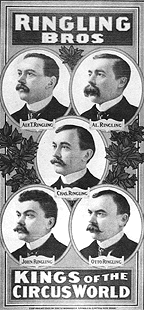 |
The
Ringling Brothers, before their other two brothers Henry and Gus joined them in running
their circus (courtesy the Ringling Museum). |
The Ringling Brothers
Five brothers from Baraboo, Wisconsin — Al, Alf, Charles, John and Otto Ringling
— were inspired to become the circus kings of the 20th century while they were still
boys. Five of the seven Ringling boys went down to the docks to see the circus unload from
a sidewheel steamboat. According to Al Ringling, after they had watched the circus unload,
his eldest brother asked “What if we had a show like that?” To his surprise, his
brothers claimed to have been thinking the same thing. Their first circus was a backyard
affair complete with feats of physical skill and daring, an animal act and a clown.
As the 19th century was coming to a close, the Ringling brothers began to build a
reputation of their own. Beginning their tented circus in 1884, they soon became known as
the Kings of the Circus World. A sixth brother, Henry Ringling, joined the show in 1886,
while Gus, the seventh brother, joined soon after.
By 1887, the Ringling brothers’ show was growing. Its official title was
“Ringling Bros. United Monster Shows, Great Double Circus, Royal European Menagerie,
Museum, Caravan, and Congress of Trained Animals”.
The Ringling brothers’ success can be attributed to hard work and specialization. Alf
Ringling did the publicity. Gus arranged for the advertising. Al picked the acts. Charles
produced the show. Henry was the one who attended each performance. Otto was the
treasurer. John took care of the transportation, and it was his skillful routing to small
or neglected towns, which permitted their circus to avoid direct clashes with their
formidable competitors.
During the 1895 season, the Ringling show invaded New England, long the stronghold of the
Barnum and Bailey Circus. At Bailey’s suggestion, the Ringling brothers agreed to
divide the US with him, establishing their headquarters in Chicago, while Barnum’s
would be New York. Neither would intrude upon the other’s territory.
As time went on, the Ring-lings’ show grew bigger. In 1907, the Ringlings finally
purchased their largest competitor — the Barnum and Bailey Circus — for
$410,000, less than the profits of one good season. For the first time in the
Ringlings’ history, all the brothers didn’t agree on the acquisition.
Charles Ringling proposed an organization of circus owners to try to eliminate practices
that gave the circus as an institution a bad reputation. In December 1910, representatives
of more than a dozen circuses agreed not to cover one another’s posters, to remove
their advertising matter promptly after show dates, and to give the public “a square
deal”.
Just prior to the US entry into WWI, the Ringling Brothers Circus had more than 1,000
personnel, 335 horses and a menagerie that included 26 elephants and 16 camels, all
traveling aboard 92 railroad cars. The Barnum and Bailey circus was about the same size.
With the US entry into the war, however, circuses suddenly couldn’t get enough help
since so many employees joined the Armed Forces. Patronage of both the Barnum and Bailey
and the Ringling shows fell dramatically. So the Ringlings combined them in 1919 as the
“Ringling Bros. and Barnum and Bailey Combined Shows, The Greatest Show on
Earth”.
The Greatest Show on Earth was becoming truly legendary, but none of John Ringling’s
six brothers lived to see what was perhaps his greatest business triumph. In 1929,
Ringling purchased the American Circus Corporation for $1.7 million. In one fell swoop,
Ringling had absorbed five major shows: Sells-Floto, Al G. Barnes, Sparks,
Hagenbeck-Wallace and John Robinson.
By the time John Ringling died in 1936, Ringling Bros. and Barnum and Bailey Circus had
become an American tradition. John Ringling North, an executor of his uncle’s estate,
became president of the show in 1937, a position he held until 1943 when his cousin,
Robert, became president.
Problems
Throughout its history, the circus has always been plagued with problems. The worst
tragedy in circus history occurred during the afternoon show of the Ringling Bros. and
Barnum and Bailey Circus on 6 July 1944, at Hartford, Connecticut.
The flame-resistant Big Top leaked badly, so for 1944 the Ringling management substituted
an old-fashioned tent waterproofed with a solution of paraffin and benzene. The coating
kept water out, but the canvas was extremely flammable.
With nearly 7,000 people enjoying the performance, the big tent suddenly caught fire. As
fire spread up the walls and raced across the top of the tent, the bandmaster, Merle
Evans, swung his band into the “Stars and Stripes Forever” — the circus
disaster tune. The sound of this tune moved all employees into high gear. The horses,
elephants, lions and tigers were quickly led out of the tent.
When the tent became engulfed in flames, the crowd broke into a stampede. They could have
escaped under the tent flaps almost anywhere, but in their panic, many tried to leave the
way they had come in, but they now found that way blocked by the animal chute used to
transport the big cats. Fire hadn’t spread to the other end yet and employees tried
directing them to that exit. In the panic, crowds still stampeded to the end on fire.
Three minutes later, the tent poles started collapsing and the roof caved in. Within six
minutes, all the tent had burned, leaving a pile of smoldering ashes. In all, 168 persons
were trampled or burned to death — at least 80 of them were children. Another 487
people, including 60 circus employees, received burns and injuries. Insurance claims came
to almost $4 million.
Times, and the public’s taste, were changing, and the circus had problems keeping
pace. On 16 July 1956, in Pittsburgh, Pennsylvania, the financially troubled Ringling
Bros. and Barnum and Bailey gave its last performance under the Big Top. John Ringling
North announced, “The tented circus as it exists today is, in my opinion, a thing of
the past.” The Big Top, North said, was the victim of TV competition, labor troubles,
terrible weather for canvas tents, traffic problems for audiences trying to get to the
circus and increased freight rates for railroads trying to bring it to them. Life magazine
announced “Big Top Bows Out Forever”.
In that same year, the Clyde Beatty Circus, by that time the only railroad circus other
than Ringling, had gone bankrupt. The decline continued throughout the 1960s. The
surviving circuses were small and, worst of all, had few superstars who could perform
crowd-pleasing feats.
 |
This
leaping tiger, designed by noted illustrator Charles Livingston Bull in 1914, is one of
the most dramatic images ever produced for a circus poster (courtesy of Ringling Bros. and
Barnum and Bailey Circus). |
The Circus’ Rebirth
Later that year, Irvin Feld would save Ringling Bros. and Barnum and Bailey from oblivion
by masterminding its transition from tents to arenas. Irvin Feld and his brother, Israel,
had made their mark as pioneers in the rock ‘n’ roll concert tour business.
Because he was familiar with the new arenas springing up in cities across the US, Feld
suggested the Greatest Show on Earth become an exclusively indoor presentation. On 3 April
1957, the new tour was put into effect with Feld in charge of booking and promotion.
Feld had always wanted to own Ringling Bros. and Barnum and Bailey and thus have control
over all facets of the show, including production. On 11 November 1967, his dream became
reality when the Feld family purchased Ringling Bros. and Barnum and Bailey from John
Ringling North.
Ever the astute promoter, Feld designed a new two-year tour system for his circus. He
leased baggage cars, in which the elephants and some other trained animals would ride,
from the railroads. The show’s equipment moved in 10 big trailer trucks. He gave the
performers travel allowances to be used in restaurants and hotels of their choice, and
ordered them to get from show to show in their own cars and trailers. Feld reduced the
number of employees from 1,400 to 300, including about 80 performers, and cut the
break-even point to $125,000. Moving the show indoors permitted 46 consecutive weeks of
performance, from the first week in January to the third week in November. Utilizing a
national advertising campaign, including television specials, he brought “The
Greatest Show on Earth” back to its rightful place as a premier American art form,
prompting Time magazine to refer to him as “The Greatest Showman On Earth”.
Feld’s success spurred the comeback of the American circus. By the late 1990s, there
were 30 circuses in the US, including the Clyde Beatty-Cole Bros. Circus, the second
largest and the largest still under a tent.
Further Reading
• Culhane, John. The American Circus (Henry Holt and Co., New York, 1990).
• Ogden, Tom. Two Hundred Years of the American Circus (Facts on File, New
York, 1993).
• Hoh, LaVahn G. and William H. Rough. Step Right Up! The Adventure of the Circus
in America (Betterway Publications, Inc.,White Hall, Virginia,1990).
• Loxton, Howard. The Golden Age of the Circus (Smithmark Publishers, New
York, 1997).
ringlingdocents.org
|





